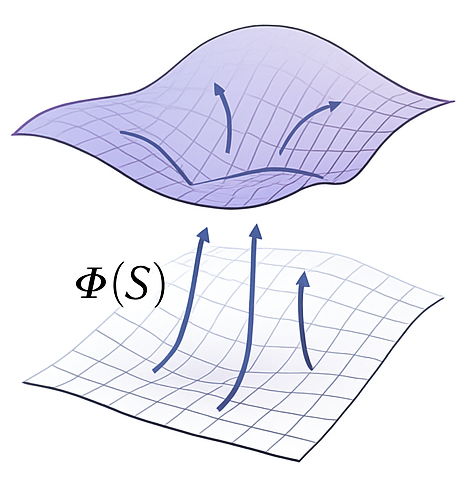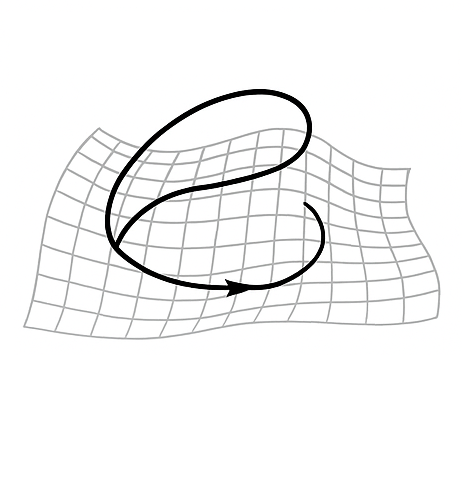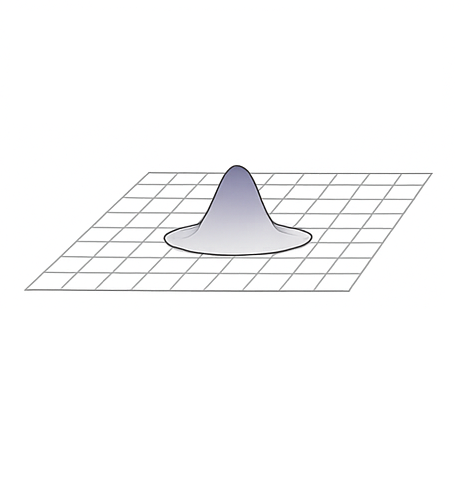Action–Wave Space (AWS) starts from a single first principle: only Action exists and its flux is conserved. From this assumption one is led to a single real scalar phase field \(\Phi\) on a four–dimensional Lorentzian–symplectic manifold \((M,g,\Omega)\). AWS is obtained by a phase–space compression: starting from the eight–dimensional cotangent bundle \(T^{*}M_{4}\) with coordinates \((x^\mu,p_\mu)\), the Hamilton–Jacobi condition \(p_\mu = \partial_\mu \Phi\) eliminates independent momentum coordinates and defines intrinsic “action–like” labels \(S^\mu\) on a reduced 4D Action–Wave Space. The closed two–form \(\Omega := d(d\Phi)\) encodes quantized Action flux on compact 2–cycles, \(\int_{\Sigma} \Omega = 2\pi n\hbar\), and the AWS field equation together with metric–symplectic compatibility follow from a single covariant, shift–symmetric action for \(\Phi\). Quantization is not postulated but emerges from global phase coherence and flux integrality on \((M,g,\Omega)\).
Observable physics appears only after projection from AWS to effective spacetime. A causal projection map \(\pi : M \to M_4\) associates to each spacetime event \(x^\mu\) a compact preimage (a “scalarton”) \(D_x = \pi^{-1}(x)\) with fixed topology \((\chi,b_1,b_2) = (2,1,3)\). A retarded kernel \(G_R(x,S)\), derived from the AWS dynamics, filters globally coherent phase configurations on \(D_x\) into spacetime amplitudes \(\psi(x) = \int_{D_x} G_R(x,S)\,A(S)\,e^{i\Phi(S)/\hbar}\,\sqrt{-g(S)}\,d^4S\). This compact, quantized fiber structure enforces interference stability and flux quantization, and it is this topology–plus–projection mechanism that underpins the emergence of the spacetime metric, quantum probabilities, gauge fields, spin/statistics, and the observed pattern of fermion generations from a single scalar phase geometry.

Single real scalar field \(\Phi(S^\mu)\) defined on a four-dimensional Lorentzian symplectic manifold \(\mathscr{M}_{\text{AWS}}\). Its phase gradients \(\partial_\mu \Phi\) generate the metric and symplectic structure, and source curvature dynamically.

Curvature leads to the formation of scalartons: compact, topologically constrained domains \(D_x = \pi^{-1}(x)\) satisfying \((\chi, b_1, b_2) = (2, 1, 3)\). These domains trap scalar flux and support interference-stable quantization.

Observable particles and fields \(\psi(x)\) in emergent spacetime arise via causal projection \(\pi: \mathscr{M}_{\text{AWS}} \to M_4\) through a scalar-derived kernel \(G_R(x, S)\).
Layer 1 – Mathematical infrastructure
- Topology selection on compact four-manifolds under integral cohomology constraints – Provides the topological backbone for the AWS framework by studying compact, oriented four-manifolds with constrained integral cohomology and curvature functionals. A natural variational principle is shown to severely restrict the allowed fiber topologies, singling out a narrow class of compact internal four-manifolds with Euler characteristic chi = 2 and second Betti number b2 = 3, together with a small set of admissible intersection forms. These results supply the topology-selection mechanism for the compact “scalarton” fibers used in AWS-Foundations, AWS-SM, and related papers, ensuring that the internal configuration space is both topologically stable and compatible with quantized flux sectors and SU(3)-like holonomy. Paper: Topology selection on compact four-manifolds under integral cohomology constraints.
- Projection kernels for parameter-dependent hyperbolic operators on globally hyperbolic Lorentzian manifolds – Develops the microlocal and operator-theoretic backbone of the AWS projection mechanism by treating the causal projection operator as a Fourier-integral operator on a globally hyperbolic spacetime with a compact internal configuration space. Under Hadamard-type assumptions, the associated Gram operator \(K = \Pi^{\dagger}\Pi\) is shown to be an elliptic pseudodifferential operator of order zero with principal symbol one, so that \(\Pi\) acts as an approximate isometry and \(K = I + R\) with a controlled order-\(-1\) remainder. These results provide the rigorous foundation for viewing the AWS projector as a near-unitary, flux-preserving map from internal fibers to spacetime, underpinning both the Born push-forward relation and the measurement dynamics developed in AWS-Measurement. Paper: Projection kernels for parameter-dependent hyperbolic operators on globally hyperbolic Lorentzian manifolds.
Layer 2 – Operational / measurement theory
- Measurement Probabilities and Outcome Selection from Causal Projection Kernels – Develops a model-independent measurement framework in which a single causal projection operator with a retarded kernel on a compact internal configuration space generates both POVMs and quantum instruments, recovers Born probabilities as push-forward measures of an approximate isometry, and yields deterministic outcome selection from a strictly convex stability functional. The theory leads to four universal, experimentally testable scaling laws for collapse time, visibility decay, deviations from ideal Born statistics, and rotated-basis transfer curves, with direct applications to continuous weak-measurement platforms such as circuit QED. Paper: Measurement probabilities and outcome selection from causal Pprojection kernels.
Layer 3 – Phenomenology / specific sectors
- AWS-SM: The Standard Model from Action–Wave Space – Derives the complete Standard Model Lagrangian as the low-energy projection of a single scalar phase field. The compact fiber topology (χ, b1, b2) = (2, 1, 3) uniquely yields the gauge group SU(3)C × SU(2)L × U(1)Y, three fermion generations, and a complex Higgs doublet. Yukawa couplings arise from geometric overlap integrals on the fiber, explaining mass hierarchies, mixing, and CP phases. Paper: AWS-SM: The Standard Model from Action–Wave Space.
- AWS-Entropy: Black-Hole Entropy from Scalar Phase Geometry – Reproduces the Bekenstein–Hawking area law and its logarithmic corrections within AWS. Black-hole entropy arises as a Wald–Noether charge, a flux-sector microstate count, and an entanglement entropy of the projection—all yielding S = A / (4 G ℏ) − (3 / 2) ln A + ⋯. No regulators or new fields are required; finiteness follows from the fixed fiber topology (χ, b₂) = (2, 3). Paper: AWS-Entropy: Black-Hole Entropy from Scalar Phase Geometry.
- AWS-H: Hydrogen Spectrum from Action–Wave Space – Derives the full hydrogen spectrum—including Bohr levels, Dirac fine structure, and radiative and hyperfine corrections—from the same geometric projection mechanism. Discrete levels arise from phase quantization and Maslov indices; spin-½ holonomy reproduces the Dirac spectrum; finite curvature damping explains the Lamb shift. This “closes the hydrogen gate,” uniting atomic physics and quantum geometry. Paper: AWS-H: Hydrogen Spectrum from Action–Wave Space.
Other works:
- On the Quantum Nature of Action and Phase – This paper reinterprets quantum behavior through the geometry of accumulated action and forms the conceptual foundation of AWS theory. It introduces a new perspective in which action is not derived from motion, but defines the coordinates of a four-dimensional manifold. Scalar phase evolves over this manifold, and energy and momentum emerge as gradients of action-space, not inputs. Quantization arises from global phase coherence around closed geodesics, making interference, discreteness, and dynamics consequences of scalar geometry. This work provides the conceptual and geometric foundation for the AWS framework. Paper: On the Quantum Nature of Action and Phase.
- Quantum Gravity from Action-Wave Space: Curvature, Quantization, and Causal Projection – AWS provides a scalar-field-based derivation of quantum gravity, replacing operator quantization with topological phase coherence and metric–symplectic compatibility. The Einstein field equations and a curvature bound \(|R| \lesssim \hbar^{-2}\) arise naturally from scalar wave dynamics. A causal projection mechanism yields classical observables and predicts testable effects in cosmology and gravitational wave physics. Paper: Quantum Gravity from Action-Wave Space: Curvature, Quantization, and Causal Projection.
Older (Pedagogical) works:
- Derivations from Action-Wave Space I: Operator-Free Quantization and the Schrodinger Equation – This paper introduces the AWS framework through a foundational derivation of non-relativistic quantum mechanics. By replacing operator algebra with phase coherence constraints on scalar fields, the Schrödinger equation and canonical structures emerge from topological quantization. It sets the stage for a geometry-based understanding of quantum theory without invoking Hilbert space axioms. Paper: Derivations from Action-Wave Space I: Operator-Free Quantization and the Schrodinger Equation.
- Derivations from Action-Wave Space II: Dirac and Klein–Gordon Equations from Phase Geometry – This work extends the AWS formalism to relativistic quantum mechanics by deriving the Dirac and Klein–Gordon equations from a scalar phase field on a Lorentzian symplectic manifold. The causal structure, spinor dynamics, and mass shells are shown to arise from topological coherence and scalar phase transport. It provides a unified geometric origin for relativistic wave equations without spinor postulates. Paper: Derivations from Action-Wave Space II: Dirac and Klein–Gordon Equations from Phase Geometry.
- Derivations from Action-Wave Space III: The Quantum Harmonic Oscillator – The energy spectrum of the quantum harmonic oscillator is derived exactly from AWS principles, using interference-stable scalar wave modes on closed geodesics. This paper demonstrates how AWS reproduces textbook results from geometric quantization alone, without operator methods. It serves as a key pedagogical link between the AWS framework and canonical quantum mechanics. Paper: Derivations from Action-Wave Space III: The Quantum Harmonic Oscillator.
- Derivations from Action-Wave Space IV: The Hydrogen Atom from Phase Quantization and Scalar Projection – This paper derives the discrete energy levels and orbital structure of the hydrogen atom from topological phase quantization in action space. The usual quantum numbers \(n\), \(\ell\), and \(m\) emerge from winding constraints on radial and angular geodesics. Without using a potential or operator quantization, AWS reproduces the hydrogen spectrum and explains projection into real-space orbitals. Paper: Derivations from Action-Wave Space IV: The Hydrogen Atom from Phase Quantization and Scalar Projection.
